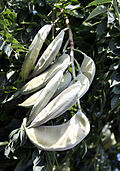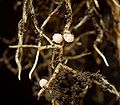Fabaceae
Fabaceae, also known as the legume, pea, or bean family, is a large and economically important family of flowering plants. It is the third-largest land plant family by number of species, with around 20,000 species classified into about 750 genera. The family is widely distributed, being found on all continents except Antarctica, and includes a variety of habitats ranging from forest to grassland. Members of the Fabaceae family are characterized by their fruit, typically a legume, a type of pod that splits into two pieces and contains seeds.
Characteristics
Fabaceae plants are most commonly herbaceous plants but also include trees and shrubs. They are easily recognized by their leaves, which are usually compound and arranged alternately along the stem. The flowers are often bilateral symmetrical and are typically hermaphroditic, containing both male and female reproductive organs. The family is notable for its ability to fix nitrogen, a process conducted by symbiotic bacteria within root nodules. This nitrogen fixation enriches the soil and reduces the need for artificial fertilizers, making Fabaceae species important in sustainable agriculture.
Classification
The Fabaceae family is divided into three subfamilies:
- Faboideae or Papilionoideae, the largest subfamily, includes well-known genera such as Pisum (peas), Medicago (alfalfa), and Trifolium (clover).
- Mimosoideae, known for genera like Acacia and Mimosa.
- Caesalpinioideae, which includes Cassia and Cercis (redbuds).
Economic Importance
Fabaceae species are of significant economic importance. Many are cultivated for their edible seeds (beans, peas, lentils), oils (soybean, peanut), and for forage (clover, alfalfa). Some species are used in timber production (e.g., Acacia, Dalbergia), and others have medicinal properties or are used in landscaping for their attractive flowers.
Ecological Role
Beyond their economic value, Fabaceae plants play a crucial ecological role. Their ability to fix nitrogen enhances soil fertility, making them key components in crop rotation and intercropping systems. They provide habitat and food for a variety of wildlife, including pollinators like bees, which are essential for the reproduction of many crops.
Conservation
While many Fabaceae species are widespread and common, some are threatened or endangered due to habitat loss, overexploitation, and climate change. Conservation efforts are essential to protect these species and maintain biodiversity.
See Also
Transform your life with W8MD's budget GLP-1 injections from $125.
W8MD offers a medical weight loss program to lose weight in Philadelphia. Our physician-supervised medical weight loss provides:
- Most insurances accepted or discounted self-pay rates. We will obtain insurance prior authorizations if needed.
- Generic GLP1 weight loss injections from $125 for the starting dose.
- Also offer prescription weight loss medications including Phentermine, Qsymia, Diethylpropion, Contrave etc.
NYC weight loss doctor appointments
Start your NYC weight loss journey today at our NYC medical weight loss and Philadelphia medical weight loss clinics.
- Call 718-946-5500 to lose weight in NYC or for medical weight loss in Philadelphia 215-676-2334.
- Tags:NYC medical weight loss, Philadelphia lose weight Zepbound NYC, Budget GLP1 weight loss injections, Wegovy Philadelphia, Wegovy NYC, Philadelphia medical weight loss, Brookly weight loss and Wegovy NYC
|
WikiMD's Wellness Encyclopedia |
| Let Food Be Thy Medicine Medicine Thy Food - Hippocrates |
Medical Disclaimer: WikiMD is not a substitute for professional medical advice. The information on WikiMD is provided as an information resource only, may be incorrect, outdated or misleading, and is not to be used or relied on for any diagnostic or treatment purposes. Please consult your health care provider before making any healthcare decisions or for guidance about a specific medical condition. WikiMD expressly disclaims responsibility, and shall have no liability, for any damages, loss, injury, or liability whatsoever suffered as a result of your reliance on the information contained in this site. By visiting this site you agree to the foregoing terms and conditions, which may from time to time be changed or supplemented by WikiMD. If you do not agree to the foregoing terms and conditions, you should not enter or use this site. See full disclaimer.
Credits:Most images are courtesy of Wikimedia commons, and templates, categories Wikipedia, licensed under CC BY SA or similar.
Contributors: Prab R. Tumpati, MD












